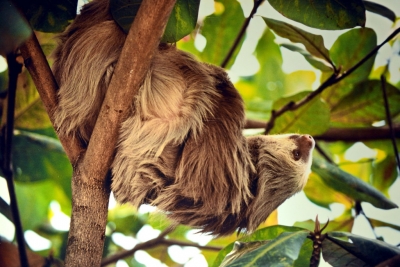
Sloths are arboreal creatures, meaning they live on trees. Earlier it was assumed that sloths never came to the ground, but later it was discovered that they do come down to the forest floor once every few days, despite it being very risky. So, why do they do that?
Sloth diet largely comprises leaves within the animal’s reach. And since leaves are poor in nutrients and calories, the calorific intake of sloths is low. To conserve whatever little energy they get from their food, sloths move slowly and only a little every day, making them “one of the least mobile mammal species on Earth”. To protect themselves from predators, these creatures must stay on trees, well camouflaged. As they cannot run from predators, being on forest floor is risky too. But they still do it once every few days – to defecate. The food they consume takes a long time to digest, and so they don’t poop often. So, sloths lug about a third of their body weight in poop before defecation. With their lives at risk, it is not exactly clear why sloths don’t simply defecate from tree canopies like other arboreal mammals. There are a few hypotheses, though.
One is that sloth poop is where the moths living on these mammals lay their eggs, When the larvae emerge, they feed on the poop, grow, fly to find the sloth, and start living on it because the moths are said to facilitate the growth of algae found in sloth hair. These algae apparently help the sloth in camouflage. Some reports also suggest that sloths consume these algae for nutrition. However, the moth-and-algae theory is contested because it has been found that “sloths in captivity that are fed a natural diet but don’t have any algae are perfectly healthy”. Another theory suggests that sloths come to the same place on the forest floor to poop as a means of communication to other sloths – to let them know of their presence, especially to potential mates.
Since neither of these theories is backed by concrete evidence, the mystery behind the sloth’s risky behavior remains unsolved.
Picture Credit : Google



